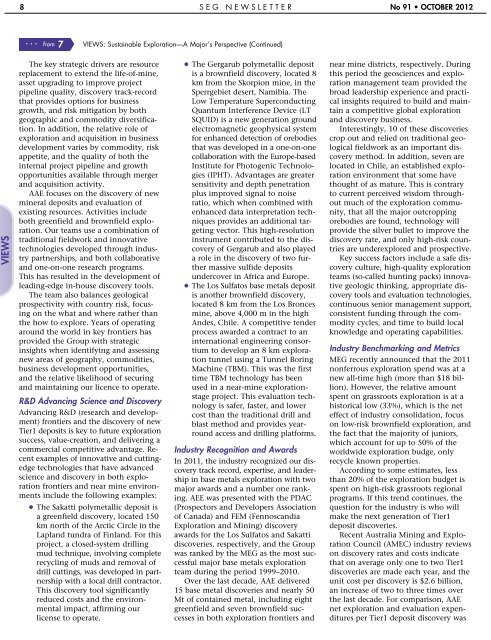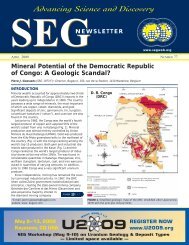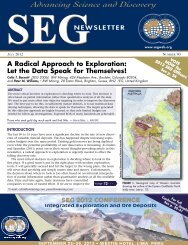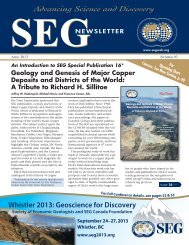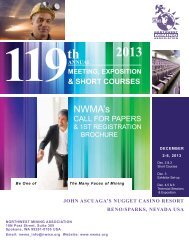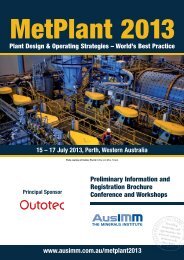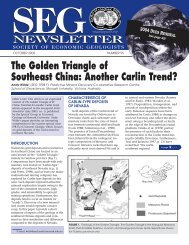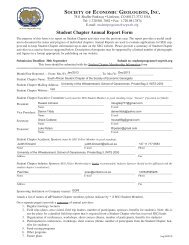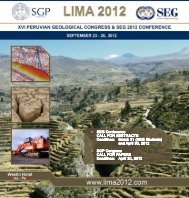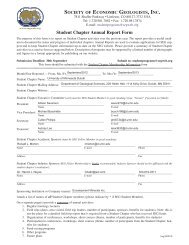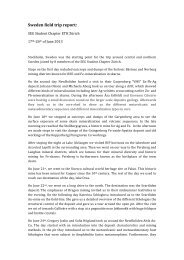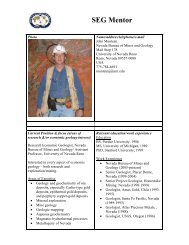SEG - Society of Economic Geologists
SEG - Society of Economic Geologists
SEG - Society of Economic Geologists
You also want an ePaper? Increase the reach of your titles
YUMPU automatically turns print PDFs into web optimized ePapers that Google loves.
8 <strong>SEG</strong> NEWSLETTER No 91 • OCTOBER 2012<br />
... from 7<br />
VIEWS: Sustainable Exploration—A Major’s Perspective (Continued)<br />
VIEWS<br />
The key strategic drivers are resource<br />
replacement to extend the life-<strong>of</strong>-mine,<br />
asset upgrading to improve project<br />
pipeline quality, discovery track-record<br />
that provides options for business<br />
growth, and risk mitigation by both<br />
geographic and commodity diversification.<br />
In addition, the relative role <strong>of</strong><br />
exploration and acquisition in business<br />
development varies by commodity, risk<br />
appetite, and the quality <strong>of</strong> both the<br />
internal project pipeline and growth<br />
opportunities available through merger<br />
and acquisition activity.<br />
AAE focuses on the discovery <strong>of</strong> new<br />
mineral deposits and evaluation <strong>of</strong><br />
existing resources. Activities include<br />
both greenfield and brownfield exploration.<br />
Our teams use a combination <strong>of</strong><br />
traditional fieldwork and innovative<br />
technologies developed through industry<br />
partnerships, and both collaborative<br />
and one-on-one research programs.<br />
This has resulted in the development <strong>of</strong><br />
leading-edge in-house discovery tools.<br />
The team also balances geological<br />
prospectivity with country risk, focusing<br />
on the what and where rather than<br />
the how to explore. Years <strong>of</strong> operating<br />
around the world in key frontiers has<br />
provided the Group with strategic<br />
insights when identifying and assessing<br />
new areas <strong>of</strong> geography, commodities,<br />
business development opportunities,<br />
and the relative likelihood <strong>of</strong> securing<br />
and maintaining our licence to operate.<br />
R&D Advancing Science and Discovery<br />
Advancing R&D (research and development)<br />
frontiers and the discovery <strong>of</strong> new<br />
Tier1 deposits is key to future exploration<br />
success, value-creation, and delivering a<br />
commercial competitive advantage. Re -<br />
cent examples <strong>of</strong> innovative and cuttingedge<br />
technologies that have advanced<br />
science and discovery in both exploration<br />
frontiers and near mine environments<br />
include the following examples:<br />
● The Sakatti polymetallic deposit is<br />
a greenfield discovery, located 150<br />
km north <strong>of</strong> the Arctic Circle in the<br />
Lapland tundra <strong>of</strong> Finland. For this<br />
project, a closed-system drilling<br />
mud technique, involving complete<br />
recycling <strong>of</strong> muds and removal <strong>of</strong><br />
drill cuttings, was developed in partnership<br />
with a local drill contractor.<br />
This discovery tool significantly<br />
reduced costs and the environmental<br />
impact, affirming our<br />
license to operate.<br />
● The Gergarub polymetallic deposit<br />
is a brownfield discovery, located 8<br />
km from the Skorpion mine, in the<br />
Sperrgebiet desert, Namibia. The<br />
Low Temperature Superconducting<br />
Quantum Interference Device (LT<br />
SQUID) is a new generation ground<br />
electromagnetic geophysical system<br />
for enhanced detection <strong>of</strong> orebodies<br />
that was developed in a one-on-one<br />
collaboration with the Europe-based<br />
Institute for Photo genic Technolo -<br />
gies (IPHT). Advan tages are greater<br />
sensitivity and depth penetration<br />
plus improved signal to noise<br />
ratio, which when combined with<br />
enhanced data interpretation techniques<br />
provides an additional targeting<br />
vector. This high-resolution<br />
instrument contributed to the discovery<br />
<strong>of</strong> Ger garub and also played<br />
a role in the discovery <strong>of</strong> two further<br />
massive sulfide deposits<br />
undercover in Africa and Europe.<br />
● The Los Sulfatos base metals deposit<br />
is another brownfield discovery,<br />
located 8 km from the Los Bronces<br />
mine, above 4,000 m in the high<br />
Andes, Chile. A competitive tender<br />
process awarded a contract to an<br />
international engineering consortium<br />
to develop an 8 km explora -<br />
tion tunnel using a Tunnel Boring<br />
Machine (TBM). This was the first<br />
time TBM technology has been<br />
used in a near-mine explorationstage<br />
project. This evaluation technology<br />
is safer, faster, and lower<br />
cost than the traditional drill and<br />
blast method and provides yearround<br />
access and drilling platforms.<br />
Industry Recognition and Awards<br />
In 2011, the industry recognized our discovery<br />
track record, expertise, and leadership<br />
in base metals exploration with two<br />
major awards and a number one ranking.<br />
AEE was presented with the PDAC<br />
(Prospectors and Developers Association<br />
<strong>of</strong> Canada) and FEM (Fenno scandia<br />
Exploration and Mining) discovery<br />
awards for the Los Sulfatos and Sakatti<br />
discoveries, respectively, and the Group<br />
was ranked by the MEG as the most successful<br />
major base metals exploration<br />
team during the period 1999–2010.<br />
Over the last decade, AAE delivered<br />
15 base metal discoveries and nearly 50<br />
Mt <strong>of</strong> contained metal, including eight<br />
greenfield and seven brownfield successes<br />
in both exploration frontiers and<br />
near mine districts, respectively. During<br />
this period the geosciences and exploration<br />
management team provided the<br />
broad leadership experience and practical<br />
insights required to build and maintain<br />
a competitive global exploration<br />
and discovery business.<br />
Interestingly, 10 <strong>of</strong> these discoveries<br />
crop out and relied on traditional geological<br />
fieldwork as an important discovery<br />
method. In addition, seven are<br />
located in Chile, an established exploration<br />
environment that some have<br />
thought <strong>of</strong> as mature. This is contrary<br />
to current perceived wisdom throughout<br />
much <strong>of</strong> the exploration community,<br />
that all the major outcropping<br />
orebodies are found, technology will<br />
provide the silver bullet to improve the<br />
discovery rate, and only high-risk countries<br />
are underexplored and prospective.<br />
Key success factors include a safe discovery<br />
culture, high-quality exploration<br />
teams (so-called hunting packs) innovative<br />
geologic thinking, appropriate discovery<br />
tools and evaluation technologies,<br />
continuous senior management support,<br />
consistent funding through the commodity<br />
cycles, and time to build local<br />
knowledge and operating capabilities.<br />
Industry Benchmarking and Metrics<br />
MEG recently announced that the 2011<br />
nonferrous exploration spend was at a<br />
new all-time high (more than $18 billion).<br />
However, the relative amount<br />
spent on grassroots exploration is at a<br />
historical low (33%), which is the net<br />
effect <strong>of</strong> industry consolidation, focus<br />
on low-risk brownfield exploration, and<br />
the fact that the majority <strong>of</strong> juniors,<br />
which account for up to 50% <strong>of</strong> the<br />
worldwide exploration budge, only<br />
recycle known properties.<br />
According to some estimates, less<br />
than 20% <strong>of</strong> the exploration budget is<br />
spent on high-risk grassroots regional<br />
programs. If this trend continues, the<br />
question for the industry is who will<br />
make the next generation <strong>of</strong> Tier1<br />
deposit discoveries.<br />
Recent Australia Mining and Explo -<br />
ration Council (AMEC) industry reviews<br />
on discovery rates and costs indicate<br />
that on average only one to two Tier1<br />
discoveries are made each year, and the<br />
unit cost per discovery is $2.6 billion,<br />
an increase <strong>of</strong> two to three times over<br />
the last decade. For comparison, AAE<br />
net exploration and evaluation expenditures<br />
per Tier1 deposit discovery was


